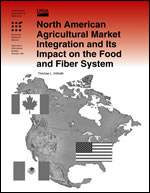North American Agricultural Market Integration and Its Impact on the Food and Fiber System
- by Thomas Vollrath
- 9/30/2003
Overview
Economic change and market dynamics have fundamentally altered the structure and performance of agricultural markets in the United States, Canada, and Mexico within the last 25 years. Many factors have helped shape the current North American food and fiber system, including technological change, domestic farm policies, international trade agreements, and the economic forces of supply and demand. Ratification of NAFTA, for example, helped spark a surge in trade and investment among the United States, Canada, and Mexico, deepening integration of North American agriculture. In recent years, efforts to further integrate the continental market seem to have slowed. Broadening the scope of NAFTA to include institutional reforms that lead to a more unified system of commercial law, the establishment of common antitrust and regulatory procedures, harmonization of product standards, and increased coordination of domestic farm, market, and macroeconomic policies would deepen market integration and enhance market efficiency and growth within North America.
Download
-
Entire report
Download PDF -
Abstract, Acknowledgments, Contents, Executive Summary
Download PDF -
The Quest for More Integrated Markets
Download PDF -
Economic Payoffs to More Unified Markets
Download PDF -
What Price Analyses Show About Cross-Border Integration in Commodity Markets
Download PDF -
What Trade Data Reveal About Market Unification Throughout North American Agriculture
Download PDF -
What the Record Shows About Integration in Capital and Labor Markets
Download PDF -
The Tradeoffs of Alternative Exchange-Rate Regimes
Download PDF -
Institutional Challenges and the Means To Deepen Continental Integration
Download PDF -
The Prospects for a Re-Energized NAFTA
Download PDF -
References
Download PDF -
Appendices
Download PDF

